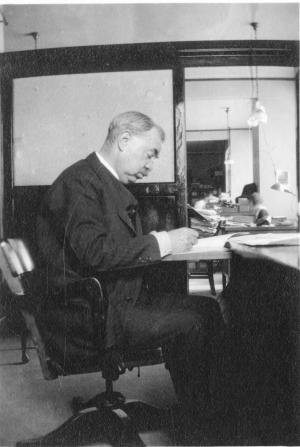As might be expected, the Science Service staff writers were also voracious readers—and not just of the technical literature.
 Before taking the helm of Science Service, E. E. (Edwin Emery) Slosson had been the editor of The Independent, a well-respected literary and public affairs magazine in New York. His book Creative Chemistry had sold hundreds of thousands of copies and Easy Lessons in Einstein (1920) and Science Remaking the World (1922) were equally successful. Slosson not only slipped easily into the role of book critic but also acted as book shopper for friends elsewhere in the world.
Before taking the helm of Science Service, E. E. (Edwin Emery) Slosson had been the editor of The Independent, a well-respected literary and public affairs magazine in New York. His book Creative Chemistry had sold hundreds of thousands of copies and Easy Lessons in Einstein (1920) and Science Remaking the World (1922) were equally successful. Slosson not only slipped easily into the role of book critic but also acted as book shopper for friends elsewhere in the world.
In late 1920, Slosson had sent copies of Carl Sandburg’s Smoke and Steeland Sinclair Lewis’s Main Street to S. H. Prior, a wealthy Australian newspaper editor. Prior wrote that he had found Main Street provocative, especially when compared to the “centralisation” of Australia, which favored large water-side metropolises rather than systems of small towns. Slosson responded in kind on February 24, 1921: “The book is of course exaggerated, satyrical [sic] and cynical but, nevertheless, depicts a type of smug parochialism that is common in our newer rural districts.”
Four years later, Slosson was compiling a list of novels on scientific topics and asked for help from Miss Margery Quigley at the Mt. Pleasant Branch Library in Washington, D.C. The librarian said she would send a list and “shall probably not include many of the automobile stories or novels about physicians but certainly one like Lewis’ ‘Arrowsmith’ dealing with the physiological research ... and the Phillpott series of novels based upon the paper and pottery industries and the like....” The latter reference is to Brunel’s Tower and Storm in a Teacup, by English author Eden Phillpotts (1862-1960).
 “It is surprising to me,” Quigley added, “how very few novels I can find which have a great scientist or research man as a hero or conspicuous character. There was one published ... called ‘The Brazen Android’ which dealt with Roger Bacon’s experiments." Quigley’s reference to a 1891 science fiction and fantasy story revealed her own inclination to explore the outer limits of literature.
“It is surprising to me,” Quigley added, “how very few novels I can find which have a great scientist or research man as a hero or conspicuous character. There was one published ... called ‘The Brazen Android’ which dealt with Roger Bacon’s experiments." Quigley’s reference to a 1891 science fiction and fantasy story revealed her own inclination to explore the outer limits of literature.
In the 1930s, medical writer Jane Stafford chose more conventional titles for weekend reading, with an eye for dramatic plots that subsequently did well on the silver screen. In January 1936 she praised the “grand humor” in Valiant Is the Word for Carrie by Barrie Benefield, which became a hit movie. By September of that year Stafford declared herself practically in social “retirement” while she read the 1037-page Gone With the Wind (“Entertaining book, but I still feel it rather a waste of time to be reading it at all.”)
It should not be surprising then that when Science Service conducted a survey of current popular science in 1939, they included novels as useful means for reaching the public. “The high survival rate of the book, as contrasted with other media, deserves recognition. ... people keep books, loan them, re-read them, hate to dispose of them and quote them as authority,” Watson Davis wrote in A Survey of the Interpretation of Science to the Public (1939).
Today, readers, authors, librarians, and historians all join Davis in saying “Hear! Hear!” Here’s to books, and those who read them!
Related Resources
Hitting the Right Note: Science or Sensationalism?, The Bigger Picture Blog, Smithsonian Institution Archives.
Not “Just Another Doll”: Two Orchids for Miss Stafford, The Bigger Picture Blog, Smithsonian Institution Archives
Popular Books in Science: A Reading List (1925), American Library Association.
Popular Books in Science: A Reading List (1929), American Library Association.
Produced by the Smithsonian Institution Archives. For copyright questions, please see the Terms of Use.

Leave a Comment